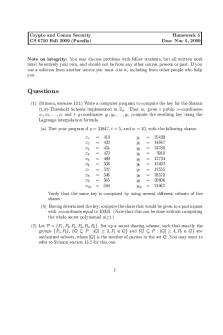Seminar Assignments - Essay \'On The Art Of Building In Ten Books\' PDF

| Title | Seminar Assignments - Essay \'On The Art Of Building In Ten Books\' |
|---|---|
| Author | Nai'lah Bell-Eaden |
| Course | World Arch: Origins To 1750 |
| Institution | University of Texas at Austin |
| Pages | 2 |
| File Size | 75.4 KB |
| File Type | |
| Total Downloads | 81 |
| Total Views | 139 |
Summary
Essay 'On the Art of Building in Ten Books'...
Description
Writing: Leon Battista Alberti, On the Art of Building in Ten Books, Joseph Rykwert, et al., The Art of Building in Ten Books has a constant homage to the writings of Vitruvius, however, Alberti takes a turn by transforming the purpose and subjects of the text into a sociological outlook of architecture. The ten books, chronologically, are Lineaments, Materials, Construction, Public Works, Works of Individuals, Ornament, Ornament to Sacred Buildings, Ornament to Public Secular Buildings, Ornament to Private Buildings, and Restoration of Buildings. The sixth book on the topic of ornament alone begins interestingly with the phrase, “The lineaments, the materials for construction, and the employment of craftsmen.” Immediately, the notion that the “employment of craftsmen” was considered as a quality of ornament for Alberti signifies his thought process—that of a connection between buildings and society. Most people would not think to include the workers when describing the effects of ornamentation. He continues to note that when we marvel at what is around us, we are struck by the sheer beauty; not utility. Beauty is seen as a quality that is desireable anywhere and creating such ornamentation brings, alongside beauty, a sign of maintenance. Ornamentation attracts us because it showcases walls that are not neglected and is more likely to be taken care of for longer periods of time. The enthusiasm of a building is a symbol of its significance and weath. And to create such marvelous structures, the skills of the artists and craftsmen were praised. The relationship that he notes between the detailing of a building and the implications that this has for the residents or visitors to the building and the artisans that were involved with the creation of the building showcases this difference between he and Vitruvius’s texts. Alberti very clearly states, “the pleasure to be found in objects of great beauty and ornament is produced either by invention and the working of the intellect, or by the hands of the craftsman… ” This statement attributes man credit for architectural feat. I agree with this in the sense that architecture has created a broad range of opportunities for society—from
providing careers to those who build to generating programmatic spaces in which people work, live, or enjoy recreational activity. His point regarding our attraction to ornamentation was also something that I had never thought of, however, makes a great deal of sense—if a structure requires maintenance and is constantly kept up, it must be representative of a place of splendor and riches. What I do not agree with, however, is that buildings lacking ornamentation are not as interesting. Ornamentation is not a prerequisite for a building to be considered beautiful, however that seems to be a great deal of what this book talks about. There is a great deal of beauty in simplicity and minimalism....
Similar Free PDFs

Seminar assignments
- 3 Pages

Seminar assignments
- 11 Pages

Essay on Defining Art
- 3 Pages

Seminar assignments - Assignment 15
- 11 Pages

Seminar assignments - Tax shield
- 1 Pages

Seminar assignments - Skew test
- 3 Pages

Seminar assignments ass1-14
- 2 Pages

Seminar assignments - everest report
- 15 Pages

Seminar assignments - Homework 5
- 1 Pages
Popular Institutions
- Tinajero National High School - Annex
- Politeknik Caltex Riau
- Yokohama City University
- SGT University
- University of Al-Qadisiyah
- Divine Word College of Vigan
- Techniek College Rotterdam
- Universidade de Santiago
- Universiti Teknologi MARA Cawangan Johor Kampus Pasir Gudang
- Poltekkes Kemenkes Yogyakarta
- Baguio City National High School
- Colegio san marcos
- preparatoria uno
- Centro de Bachillerato Tecnológico Industrial y de Servicios No. 107
- Dalian Maritime University
- Quang Trung Secondary School
- Colegio Tecnológico en Informática
- Corporación Regional de Educación Superior
- Grupo CEDVA
- Dar Al Uloom University
- Centro de Estudios Preuniversitarios de la Universidad Nacional de Ingeniería
- 上智大学
- Aakash International School, Nuna Majara
- San Felipe Neri Catholic School
- Kang Chiao International School - New Taipei City
- Misamis Occidental National High School
- Institución Educativa Escuela Normal Juan Ladrilleros
- Kolehiyo ng Pantukan
- Batanes State College
- Instituto Continental
- Sekolah Menengah Kejuruan Kesehatan Kaltara (Tarakan)
- Colegio de La Inmaculada Concepcion - Cebu






